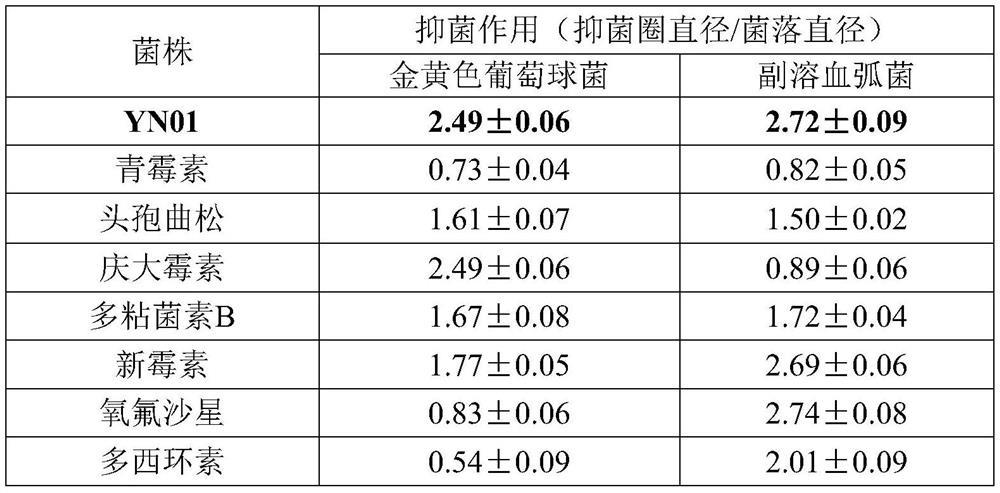Micro-ecological composite additive for aquatic products and application of micro-ecological composite additive
A composite additive, micro-ecological technology, applied in the application, additional food elements, bacteria used in food preparation, etc., can solve the problems of low quality of fermented feed, acid resistance, poor acid production ability, slow fermentation rate, etc. Immunity, strong acid resistance, high content of viable bacteria
- Summary
- Abstract
- Description
- Claims
- Application Information
AI Technical Summary
Problems solved by technology
Method used
Image
Examples
Embodiment 1
[0028] Isolation, screening and identification of embodiment 1 bacterial strain
[0029] 1. Sample source
[0030] Collected from the sediment of Litopenaeus vannamei farm in Jiaozhou City, Qingdao.
[0031] 2. Screening method
[0032] Take the sediment sample, add sterile saline, shake well for 1 hour (28°C, 150rpm), so that the bacteria in the sediment are fully dispersed in the saline, 10-fold gradient dilution, inoculated on 2216E, TSB and MRS solid medium respectively Incubate at 28°C for 24h-48h. Select a uniform and clear single colony and streak to purify the bacteria. The single colonies were named MST1, MST2, MST3, . . . , MST30 accordingly.
[0033] Use 6mol·L -1 hydrochloric acid to adjust the pH of the MRS liquid medium to 6.5, 5.0, 3.5 and 2.0, respectively. After activating the above-mentioned single colony obtained by isolation and purification and culturing to the logarithmic growth phase, inoculate 1% of the inoculum into MRS liquid medium with a pH of...
Embodiment 2
[0045] Embodiment 2 Lactobacillus plantarum YN01 antibacterial performance evaluation
[0046] Using Staphylococcus aureus and Vibrio parahaemolyticus as indicator bacteria, the differences in antibacterial effects between Lactobacillus plantarum YN01 and antibiotics were compared. The antibiotics used were penicillin, ceftriaxone, gentamicin, polymyxin B, neomycin, ofloxacin, doxycycline, and NA was used as the antibacterial test plate medium.
[0047] Spot the Lactobacillus plantarum YN01 bacterial solution on the plate coated with indicator bacteria, place the antibiotic sensitive paper, and incubate at a constant temperature of 28°C, observe within 48 hours whether there is an antibacterial transparent area or around the area where the drug sensitive paper is placed. The coverage area, the specific results are shown in Table 3.
[0048] The antibacterial situation of table 3 Lactobacillus plantarum YN01
[0049]
[0050] It can be seen from the data in Table 3 that th...
Embodiment 3
[0051] Embodiment 3 Lactobacillus plantarum YN01 produces protease ability assay
[0052] Insert Lactobacillus plantarum YN01 into MRS liquid medium, culture at 37°C for 24h, and continuously transfer and activate two generations, insert 1% ( / v / v) inoculum into 250mL MRS liquid medium, and culture at 37°C for 48h Centrifuge at 8000 r / min for 10 min at 4°C, collect the supernatant, and detect the protease activity in the supernatant by the following method.
[0053] The results show that the protease activity in the fermentation supernatant of Lactobacillus plantarum YN01 screened by the present invention is as high as 112U / mL, and unexpected technical effects have been achieved.
[0054] (1) Definition of enzyme activity: at 37°C, the amount of enzyme required to decompose bovine serum albumin to produce 1 μmol of tryptophan per minute is one enzyme activity unit.
[0055] (2) Enzyme activity assay method: take 50 μL concentration of 1% (w / v) bovine serum albumin (BSA), 450 μ...
PUM
 Login to View More
Login to View More Abstract
Description
Claims
Application Information
 Login to View More
Login to View More - R&D
- Intellectual Property
- Life Sciences
- Materials
- Tech Scout
- Unparalleled Data Quality
- Higher Quality Content
- 60% Fewer Hallucinations
Browse by: Latest US Patents, China's latest patents, Technical Efficacy Thesaurus, Application Domain, Technology Topic, Popular Technical Reports.
© 2025 PatSnap. All rights reserved.Legal|Privacy policy|Modern Slavery Act Transparency Statement|Sitemap|About US| Contact US: help@patsnap.com



